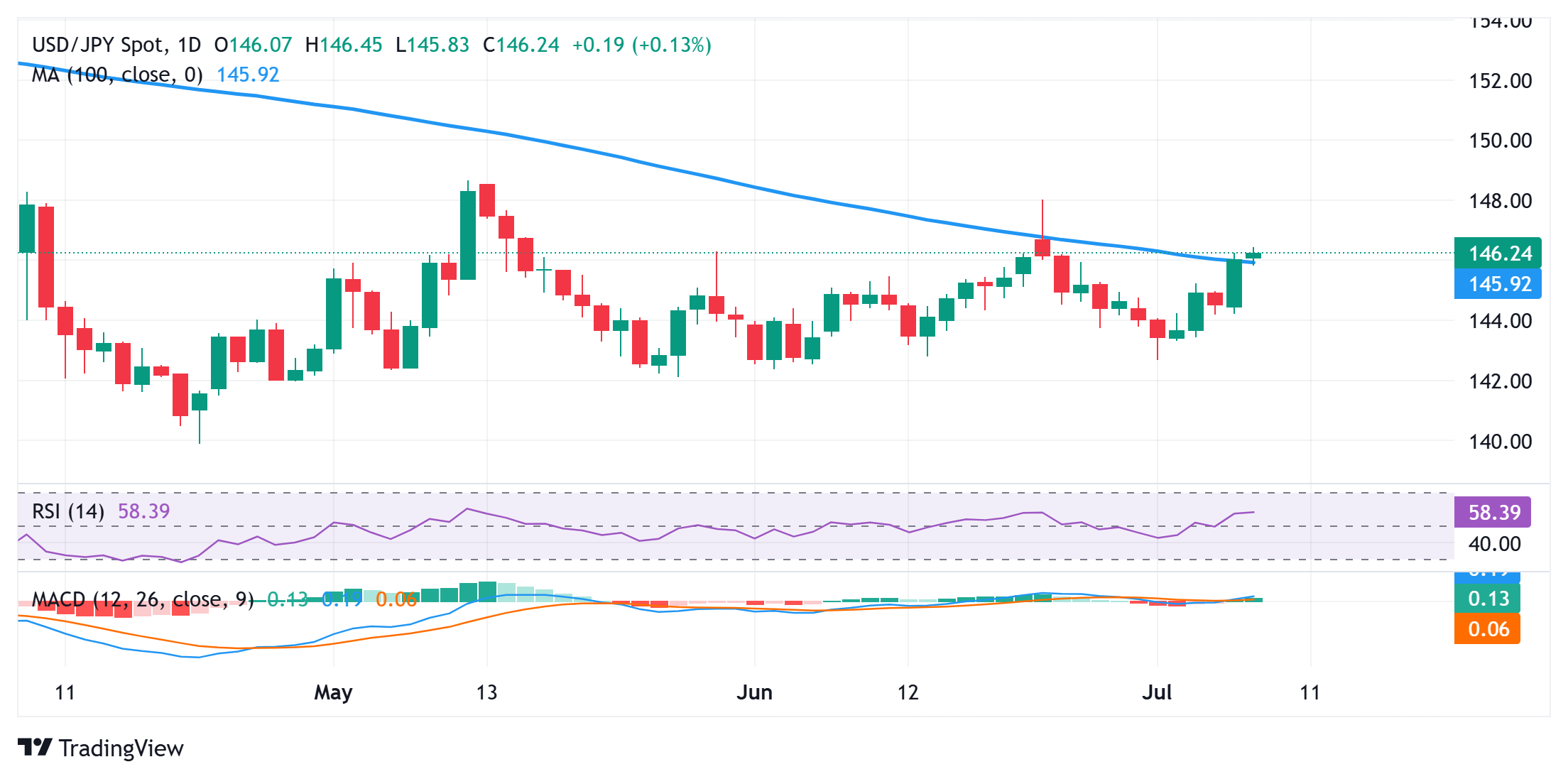Created
: 2025.07.08














![]() 2025.07.08 11:23
2025.07.08 11:23
The Japanese Yen (JPY) drifts lower against a weaker US Dollar (USD) for the second successive day and slides to over a two-week low during the Asian session on Tuesday. US President Donald Trump escalated the trade war and announced that his administration would impose a 25% tariff on goods imported from Japan, effective August 1. Adding to this, weak wage growth data released from Japan on Monday could further complicate the Bank of Japan's (BoJ) path to normalising monetary policy and turn out to be a key factor weighing on the JPY.
The JPY bulls seem rather unimpressed and largely shrugged off data showing that Japan's current account surplus rose more than expected, to ¥3,436.4 billion in May 2025 from ¥2,949.5 billion a year earlier. Meanwhile, concerns about the economic impact of Trump's tariffs and geopolitical risks stemming from fresh conflicts in the Middle East temper investors' appetite for riskier assets. This is evident from a sea of red across the global equity markets, which could support the safe-haven JPY and cap the USD/JPY pair amid renewed USD selling.

From a technical perspective, the USD/JPY pair looks to build on the momentum beyond the 100-day Simple Moving Average (SMA). Given that oscillators on the daily chart have been gaining positive traction, some follow-through buying beyond the Asian session peak, around the 146.45 region, should allow spot prices to reclaim the 147.00 round figure. The momentum could extend further towards the 147.60 intermediate hurdle en route to the June monthly swing high, around the 148.00 mark.
On the flip side, corrective pullbacks might now find some support around the 145.65-145.60 horizontal zone. Any further slide could be seen as a buying opportunity and remain limited near the 145.00 psychological mark. The latter should act as a pivotal point, which if broken decisively could drag the USD/JPY pair to the next relevant support near the 144.35-144.30 area en route to the 144.00 round figure.
Tariffs are customs duties levied on certain merchandise imports or a category of products. Tariffs are designed to help local producers and manufacturers be more competitive in the market by providing a price advantage over similar goods that can be imported. Tariffs are widely used as tools of protectionism, along with trade barriers and import quotas.
Although tariffs and taxes both generate government revenue to fund public goods and services, they have several distinctions. Tariffs are prepaid at the port of entry, while taxes are paid at the time of purchase. Taxes are imposed on individual taxpayers and businesses, while tariffs are paid by importers.
There are two schools of thought among economists regarding the usage of tariffs. While some argue that tariffs are necessary to protect domestic industries and address trade imbalances, others see them as a harmful tool that could potentially drive prices higher over the long term and lead to a damaging trade war by encouraging tit-for-tat tariffs.
During the run-up to the presidential election in November 2024, Donald Trump made it clear that he intends to use tariffs to support the US economy and American producers. In 2024, Mexico, China and Canada accounted for 42% of total US imports. In this period, Mexico stood out as the top exporter with $466.6 billion, according to the US Census Bureau. Hence, Trump wants to focus on these three nations when imposing tariffs. He also plans to use the revenue generated through tariffs to lower personal income taxes.
![]()
Created
: 2025.07.08
![]()
Last updated
: 2025.07.08

FXStreet is a forex information website, delivering market analysis and news articles 24/7.
It features a number of articles contributed by well-known analysts, in addition to the ones by its editorial team.
Founded in 2000 by Francesc Riverola, a Spanish economist, it has grown to become a world-renowned information website.
We hope you find this article useful. Any comments or suggestions will be greatly appreciated.
We are also looking for writers with extensive experience in forex and crypto to join us.
please contact us at [email protected].
Disclaimer:
All information and content provided on this website is provided for informational purposes only and is not intended to solicit any investment. Although all efforts are made in order to ensure that the information is correct, no guarantee is provided for the accuracy of any content on this website. Any decision made shall be the responsibility of the investor and Myforex does not take any responsibility whatsoever regarding the use of any information provided herein.
The content provided on this website belongs to Myforex and, where stated, the relevant licensors. All rights are reserved by Myforex and the relevant licensors, and no content of this website, whether in full or in part, shall be copied or displayed elsewhere without the explicit written permission of the relevant copyright holder. If you wish to use any part of the content provided on this website, please ensure that you contact Myforex.
Myforex uses cookies to improve the convenience and functionality of this website. This website may include cookies not only by us but also by third parties (advertisers, log analysts, etc.) for the purpose of tracking the activities of users. Cookie policy